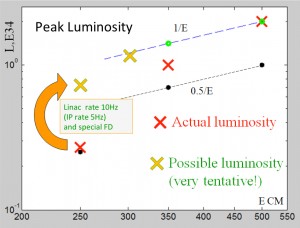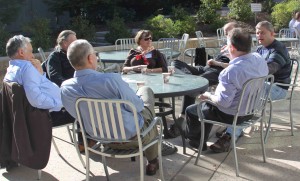
Luminosity parameters across the operational energy range (200-500 GeV centre-of-mass). Courtesy of Andrei Seryi.
As a guest columnist for the Director’s Corner, it is my turn to supply this article approximately once every eleven months. Looking back I see that my last column was just before the LCWS 10 workshop held in Beijing. Interestingly enough, I now find myself on the tail end of another GDE workshop, the recent Baseline Assessment Workshop (BAW) held at SLAC last week (18 to 21 January), where over 70 scientists came together to discuss the baseline parameters and layout for the updated ILC design we will use for the Technical Design Report (TDR) due at the end of 2012.
The SLAC BAW was the second and last such workshop of the so-called Top Level Change Control (TLCC) process, which has been going on for the last twelve months. The first BAW was held in September at KEK, where the issues of accelerating gradient and the adoption of a single-tunnel scheme for the main linacs were the focus. Both of these proposals have since been successfully concluded and are now formally part of the TDR baseline, as reported in these columns (9 December 2010 and 16 December 2010). The SLAC BAW focused on the two remaining TLCC themes: a reduced beam-power parameter set and the location and layout of the positron source. For four solid days last week the details of the two proposals were put under the microscope; the workshop represents the culmination of almost ten months of hard work by our design team, and on behalf of my fellow project managers I would like to take this opportunity to thank them for their continued support. Having passed the initial test of the BAW itself, the project managers will now make formal written proposals to the director for his final review and decision.
I will leave the technical details of these important design modifications to a later Director’s Corner (I hope after they are formally accepted as baseline). Instead I would like to spend the remainder of this column discussing the importance of the TLCC process itself from the perspective of the project managers.
The TLCC process was effectively ‘born’ from comments from two of our oversight committees: the director’s Accelerator Advisory Panel (AAP) and the ILCSC PAC, which is the GDE’s top-level oversight committee. When the project managers submitted their detailed proposals for baseline modifications in December 2009, first the AAP and then the PAC identified several areas that they felt required more attention. In particular, both committees noted a disconnect with the physics and detector community that needed to be addressed. While it is true that TLCC was formally put into place to deal with technical issues associated the change requests – breaking the original monolithic proposal into more manageable ‘chunks’ that could be dealt with individually – an important goal of the process itself was better involvement and communication with the ILC stakeholders in general, and specifically with the physics and detector groups. Research Director Sakue Yamada identified a group of five representatives from the physics and detector community to work closely with the project managers during the TLCC process, helping to organise the BAWs and to act as primary points of contact for the GDE to the broader community. These five representatives (Jim Brau, Karsten Büßer, Keisuke Fujii, Tom Markiewicz and Mark Thompson) have been an invaluable part of our ‘design team’ for the last ten or so months.
The results of these labours were very evident at last week’s workshop. Over 30 representatives from the physics and detector community attended the workshop. Unlike the agenda for the KEK BAW, which focused entirely on machine technicalities, a section of the SLAC BAW was dedicated to presentations on the physics impact of the proposed new parameters. Indeed much of the past year’s work has been focused on ‘other’ centre-of-mass running scenarios below 500 GeV, which have certainly been neglected up to this point. As a result, the SLAC BAW concluded a set of working parameters and operations scenarios across the energy range of 200-500 GeV, which supports the broader physics case.
These studies are an excellent example of what we can do when the machine designers get together with the physics and detector community. The project managers recognise the need to maintain these now established lines of communication into the next level of design work foreseen in part 2 of the Technical Design Phase (TDP 2). While many of these detailed design issues will have no direct relevance to the physics and detectors, it is still crucial that we maintain the open and transparent mechanisms we have established during the TLCC progress to keep the broader community informed. We intend to further establish these efforts as we begin the TDP 2 efforts at the upcoming ALCPG workshop in March.
As a final remark, I would like to thank the physics and detector representatives who have engaged and helped with the TLCC process. Without your input and hard work, we would not have been able been able to achieve the consensus on the baseline modifications now being proposed. We look forward to continued close cooperation as we work towards the Technical Design Report in 2012.



Recent Comments